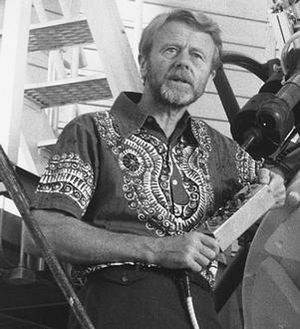Tom Gehrels facts for kids
Quick facts for kids
Tom Gehrels
|
|
|---|---|

Gehrels at Spacewatch Telescope 1980's
|
|
| Born | February 21, 1925 |
| Died | July 11, 2011 (aged 86) Tucson, Arizona, United States
|
| Nationality | Dutch–American |
| Occupation | Astronomer |
Anton M.J. "Tom" Gehrels (February 21, 1925 – July 11, 2011) was a Dutch-American astronomer. He was also a Professor of Planetary Sciences at the University of Arizona in Tucson.
Contents
About Tom Gehrels
Early Life and School
Tom Gehrels was born in Haarlemmermeer, Netherlands, on February 21, 1925. When he was a teenager, during World War II, he joined the Dutch resistance. This group secretly worked against the German forces. He even went to England and then parachuted back into the Netherlands to help with sabotage missions.
After the war, Tom went to the Leiden University in the Netherlands. He earned a degree in physics and astronomy in 1951. He then continued his studies at the University of Chicago. In 1956, he received his doctorate in astronomy and astrophysics. In 1960, he moved to the University of Arizona. He stayed there for 50 years, making many important discoveries.
Discovering Space
Tom Gehrels was a pioneer in studying asteroids. In the 1950s, he created the first system to measure how bright asteroids are. He also studied how the light from stars and planets changes.
He worked with a husband and wife team, Cornelis Johannes van Houten and Ingrid van Houten-Groeneveld. Together, they found over 4,000 asteroids! These included Apollo asteroids, Amor asteroids, and Trojan asteroids. They used a large telescope at Palomar Observatory. They would send the telescope plates to the Dutch astronomers, who would then look for new asteroids. Tom also discovered several comets.
| 64P/Swift-Gehrels* | 8 February 1973 |
| 78P/Gehrels 2 | 29 September 1973 |
| 82P/Gehrels 3 | 27 October 1975 |
| * found again after Swift found it in 1889 | |
|---|---|
| 1778 Alfvén | 26 September 1960 |
| 1864 Daedalus | 24 March 1971 |
| 1873 Agenor | 25 March 1971 |
| 1979 Sakharov | 24 September 1960 |
| 2247 Hiroshima | 24 September 1960 |
| also see Discoveries by Tom Gehrels | |
|---|---|
Tom Gehrels was also the main scientist for an experiment on the Pioneer 10 and Pioneer 11 spacecraft. These were the first missions to fly past Jupiter and Saturn in the 1970s.
He started the Space Science Series of textbooks. He was the main editor for the first 30 books in this series. He also started the Spacewatch program in 1980. This program uses electronic surveys to study asteroids and comets, especially those that come close to Earth.
Tom Gehrels taught college classes about space. He also gave lectures in India. His later research focused on cosmology, which is the study of the universe's origin and evolution. In 2007, he won the Masursky Award for his amazing work in planetary science.
Tom Gehrels was married to Aleida J. Gehrels. They had three children: Neil Gehrels, George Gehrels, and Jo-Ann Gehrels. He passed away in Tucson, Arizona. A small planet, 1777 Gehrels, was named in his honor.
Career Highlights
- Special airborne services in Europe and Far East, 1944–1948.
- Earned his B.Sc. in astronomy and physics from Leiden University in 1951.
- Received his Ph.D. in astronomy and astrophysics from the University of Chicago in 1956.
- Professor of Planetary Sciences and Astronomy at the University of Arizona, 1961–2011.
Books He Wrote or Edited
- Physical Studies of Minor Planets, edited by Tom Gehrels (1971), NASA SP-267
- Planets Stars and Nebulae Studied With Photopolarimetry, edited by Tom Gehrels (1974) Tucson: University of Arizona Press ISBN: 0-8165-0428-8
- Jupiter: Studies of the Interior, Atmosphere, Magnetosphere, and Satellites, edited by Tom Gehrels and Mildred Shapley Matthews (1976) Tucson: University of Arizona Press ISBN: 0-8165-0530-6
- Protostars & Planets: Studies of Star Formation and of the Origin of the Solar System, edited by Tom Gehrels and Mildred Shapley Matthews (1978) Tucson: University of Arizona Press ISBN: 0-8165-0674-4
- Asteroids, edited by Tom Gehrels and Mildred Shapley Matthews (1979), ISBN: 0-8165-0695-7
- Saturn, edited by Tom Gehrels and Mildred Shapley Matthews (1984) Tucson: University of Arizona Press ISBN: 0-8165-0829-1
- Asteroids II, edited by Richard P. Binzel, Tom Gehrels, and Mildred Shapely Matthews (1989)Tucson: University of Arizona Press ISBN: 0-8165-1123-3
- Hazards Due to Comets and Asteroids, edited by Tom Gehrels, Mildred Shapley Matthews, and A. M. Schumann (1994) Tucson: University of Arizona Press ISBN: 0-8165-1505-0
- On the Glassy Sea, in Search of a Worldview, Tom Gehrels (2007, originally published in 1988), ISBN: 1-4196-8247-4
- Survival Through Evolution: From Multiverse to Modern Society, Tom Gehrels (2007), ISBN: 1-4196-7055-7
- "The Chandra Multiverse", in From Big Bang to Galactic Civilizations: A Big History Anthology, Volume 3, The Ways that Big History Works: Cosmos, Life, Society, and our Future, eds. Barry Rodrigue, Leonid Grinin, Andrey Korotayev, Delhi: Primus Books, 2017, pp. 45-70.
See also
 In Spanish: Tom Gehrels para niños
In Spanish: Tom Gehrels para niños 
- Ida Barney
- Palomar–Leiden survey

